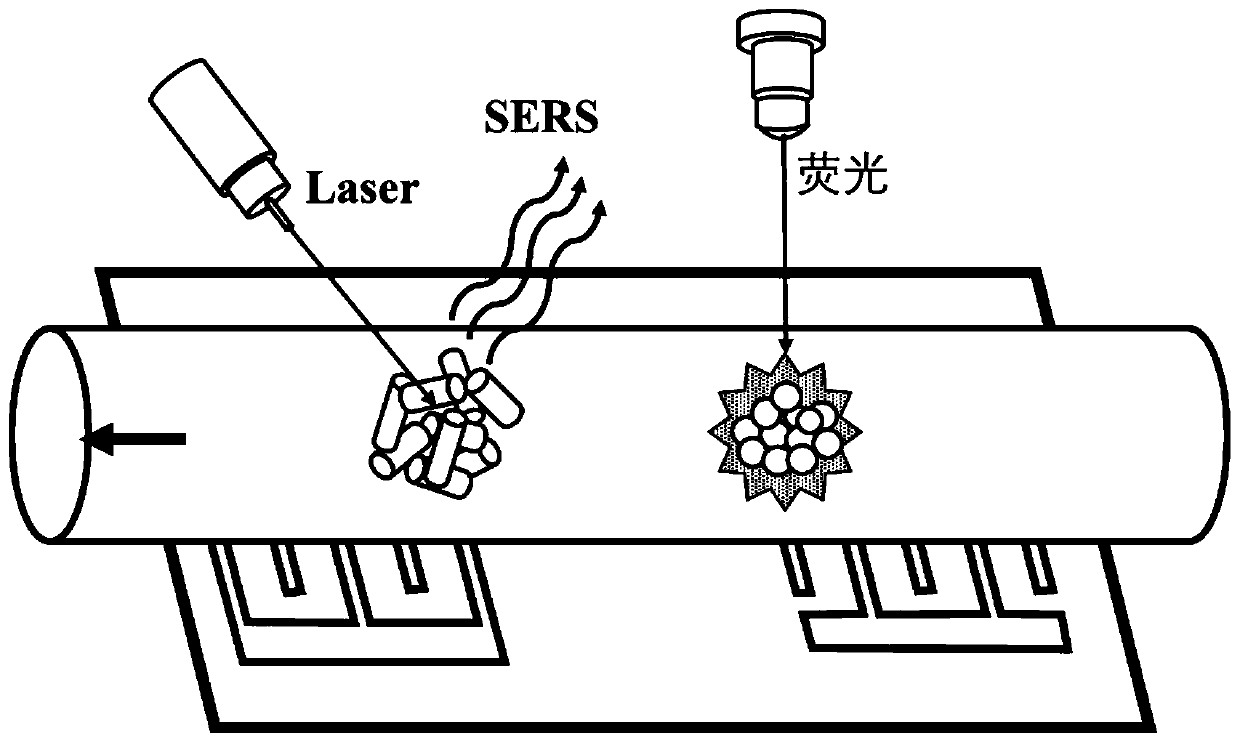Capillary analysis detection method based on ultrasonic aggregation
A detection method and capillary technology, applied in the field of analytical chemistry, can solve the problems of inconvenience in wide-scale promotion, long-term storage, complicated capillary, etc., and achieve the effect of fast detection speed and low detection limit.
- Summary
- Abstract
- Description
- Claims
- Application Information
AI Technical Summary
Problems solved by technology
Method used
Image
Examples
Embodiment 1
[0037] This embodiment relates to a SERS detection and verification of a capillary analysis and detection device based on ultrasonic aggregation. The nanoparticles used are gold nanorods. The specific verification method is as follows:
[0038] Step 1, construction of capillary-based microfluidic automatic detection ultrasonic device:
[0039] A zinc oxide layer was deposited on the FTO glass substrate by electromagnetic sputtering, and an aluminum film was deposited by chemical vapor phase on the zinc oxide layer. When depositing the aluminum film layer, Kapton tape was used to cover the central part of the zinc oxide layer. The interdigital transducer (IDT) is formed by wiring on the four sides of the aluminum film through traditional photolithography and lift-off technology, and the IDT is connected with the signal generator and signal amplifier through wires.
[0040] The signal generator uses two wires to input the sound wave signal into the signal amplifier, and then the...
Embodiment 2
[0052]This embodiment relates to a fluorescence detection verification of a capillary analysis and detection device based on ultrasonic aggregation. The specific steps of the fluorescence detection are basically the same as those in Example 1, except that:
[0053] The nanoparticles were replaced with polystyrene nanoparticles.
[0054] The step 2 is replaced by DNA modification on the surface of polystyrene nanoparticles, specifically: adding 3 to 8 mg of polystyrene microspheres containing carboxyl groups on the surface to 0.5 mL to 1.5 mL of Tris-HCl buffer solution and sonicating for 5 ~10min, then add 1mL~2mL EDC (5mmol / L) and 0.25mL~0.5mLNHS (2mmol / L) to activate for 10~20min, then add 50~100μL DNA solution (50μg / mL), shake reaction at room temperature for 45min~60min After centrifugation, wash with Tris-HCl buffer several times and centrifuge, and finally disperse and dissolve in Tris-HCl buffer.
[0055] In the detection step of the target object, the fluorescent mole...
Embodiment 3
[0060] This embodiment is basically the same as the SERS detection of the capillary analysis and detection device based on ultrasonic aggregation in Embodiment 1, except that:
[0061] In the DNA modification step of the gold nanorods, the DNA sequence used is: 5'-TGC ATC CAG GTC ATG-SH-3';
[0062] The single-stranded DNA sequence to be tested is: 5'-AGA AGA TAT TTG GAA TAA CAT GAC CTG GATGCA-3';
[0063] During the target detection process, the signal molecule chain is mixed with the target and the modified gold nanorods and injected into the capillary, wherein the signal molecule sequence is: 5'-ROX-TTA TTC CAA ATA TCT TCT-3';
[0064] The signal molecule chain can base-pair with the trace target, so that the target has a SERS signal molecule;
[0065] The detection schematic diagram of this embodiment is as follows Figure 6 shown.
PUM
 Login to View More
Login to View More Abstract
Description
Claims
Application Information
 Login to View More
Login to View More - R&D
- Intellectual Property
- Life Sciences
- Materials
- Tech Scout
- Unparalleled Data Quality
- Higher Quality Content
- 60% Fewer Hallucinations
Browse by: Latest US Patents, China's latest patents, Technical Efficacy Thesaurus, Application Domain, Technology Topic, Popular Technical Reports.
© 2025 PatSnap. All rights reserved.Legal|Privacy policy|Modern Slavery Act Transparency Statement|Sitemap|About US| Contact US: help@patsnap.com



